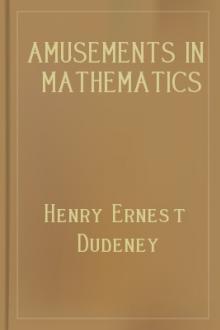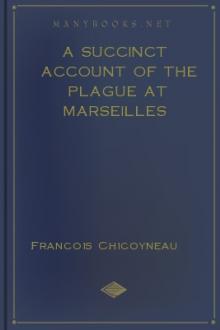Amusements in Mathematics, Henry Ernest Dudeney [books to read to be successful txt] 📗

- Author: Henry Ernest Dudeney
- Performer: 0486204731
Book online «Amusements in Mathematics, Henry Ernest Dudeney [books to read to be successful txt] 📗». Author Henry Ernest Dudeney
The position after the sixteenth move, with the mate in three moves, was first given by S. Loyd in Chess Nuts.
352.—IMMOVABLE PAWNS.—solution
Black plays precisely the same moves as White, and therefore we give one set of moves only. The above seventeen moves are the fewest possible.
353.—THIRTY-SIX MATES.—solution
Place the remaining eight White pieces thus: K at KB 4th, Q at QKt 6th, R at Q 6th, R at KKt 7th, B at Q 5th, B at KR 8th, Kt at QR 5th, and Kt at QB 5th. The following mates can then be given:—
Is it possible to construct a position in which more than thirty-six different mates on the move can be given? So far as I know, nobody has yet beaten my arrangement.
354.—AN AMAZING DILEMMA.—solution
Mr Black left his king on his queen's knight's 7th, and no matter what piece White chooses for his pawn, Black cannot be checkmated. As we said, the Black king takes no notice of checks and never moves. White may queen his pawn, capture the Black rook, and bring his three pieces up to the attack, but mate is quite impossible. The Black king cannot be left on any other square without a checkmate being possible.
The late Sam Loyd first pointed out the peculiarity on which this puzzle is based.
355.—CHECKMATE!—solution
Remove the White pawn from B 6th to K 4th and place a Black pawn on Black's KB 2nd. Now, White plays P to K 5th, check, and Black must play P to B 4th. Then White plays P takes P en passant, checkmate. This was therefore White's last move, and leaves the position given. It is the only possible solution.
356.—QUEER CHESS.—solution

If you place the pieces as follows (where only a portion of the board is given, to save space), the Black king is in check, with no possible move open to him. The reader will now see why I avoided the term "checkmate," apart from the fact that there is no White king. The position is impossible in the game of chess, because Black could not be given check by both rooks at the same time, nor could he have moved into check on his last move.
I believe the position was first published by the late S. Loyd.
357.—ANCIENT CHINESE PUZZLE.—solution
Play as follows:—
Black's moves are forced, so need not be given.
358.—THE SIX PAWNS.—solution
The general formula for six pawns on all squares greater than 22 is this: Six times the square of the number of combinations of n things taken three at a time, where n represents the number of squares on the side of the board. Of course, where n is even the unoccupied squares in the rows and columns will be even, and where n is odd the number of squares will be odd. Here n is 8, so the answer is 18,816 different ways. This is "The Dyer's Puzzle" (Canterbury Puzzles, No. 27) in another form. I repeat it here in order to explain a method of solving that will be readily grasped by the novice. First of all, it is evident that if we put a pawn on any line, we must put a second one in that line in order that the remainder may be even in number. We cannot put four or six in any row without making it impossible to get an even number in all the columns interfered with. We have, therefore, to put two pawns in each of three rows and in each of three columns. Now, there are just six schemes or arrangements that fulfil these conditions, and these are shown in Diagrams A to F, inclusive, on next page.

I will just remark in passing that A and B are the only distinctive arrangements, because, if you give A a quarter-turn, you get F; and if you give B three quarter-turns in the direction that a clock hand moves, you will get successively C, D, and E. No matter how you may place your six pawns, if you have complied with the conditions of the puzzle they will fall under one of these arrangements. Of course it will be understood that mere expansions do not destroy the essential character of the arrangements. Thus G is only an expansion of form A. The solution therefore consists in finding the number of these expansions. Supposing we confine our operations to the first three rows, as in G, then with the pairs a and b placed in the first and second columns the pair c may be disposed in any one of the remaining six columns, and so give six solutions. Now slide pair b into the third column, and there are five possible positions for c. Slide b into the fourth column, and c may produce four new solutions. And so on, until (still leaving a in the first column) you have b in the seventh column, and there is only one place for c—in the eighth column. Then you may put a in the second column, b in the third, and c in the fourth, and start sliding c and b as before for another series of solutions.
We find thus that, by using form A alone and confining our operations to the three top rows, we get as many answers as there are combinations of 8 things taken 3 at a time. This is (8 × 7 × 6)/(1 × 2 × 3) = 56. And it will at once strike the reader that if there are 56 different ways of electing the columns, there must be for each of these ways just 56 ways of selecting the rows, for we may simultaneously work that "sliding" process downwards to the very bottom in exactly the same way as we have worked from left to right. Therefore the total number of ways in which form A may be applied is 56 × 6 = 3,136. But there are, as we have seen, six arrangements, and we have only dealt with one of these, A. We must, therefore, multiply this result by 6, which gives us 3,136 × 6 = 18,816, which is the total number of ways, as we have already stated.
359.—COUNTER SOLITAIRE.—solution
Play as follows: 3—11, 9—10, 1—2, 7—15, 8—16, 8—7, 5—13, 1—4, 8—5, 6—14, 3—8, 6—3, 6—12, 1—6, 1—9, and all the counters will have been removed, with the exception of No. 1, as required by the conditions.
360.—CHESSBOARD SOLITAIRE.—solution
Play as follows: 7—15, 8—16, 8—7, 2—10, 1—9, 1—2, 5—13, 3—4, 6—3, 11—1, 14—8, 6—12, 5—6, 5—11, 31—23, 32—24, 32—31, 26—18, 25—17, 25—26, 22—32, 14—22, 29—21, 14—29, 27—28, 30—27, 25—14, 30—20, 25—30, 25—5. The two counters left on the board are 25 and 19—both belonging to the same group, as stipulated—and 19 has never been moved from its original place.
I do not think any solution is possible in which only one counter is left on the board.
361.—THE MONSTROSITY.—solution
And the position is reached.
The order of the moves is immaterial, and this order may be greatly varied. But, although many attempts have been made, nobody has succeeded in reducing the number of my moves.
362.—THE WASSAIL BOWL.—solution
The division of the twelve pints of ale can be made in eleven manipulations, as below. The six columns show at a glance the quantity of ale in the barrel, the five-pint jug, the three-pint jug, and the tramps X, Y, and Z respectively after each manipulation.





Comments (0)